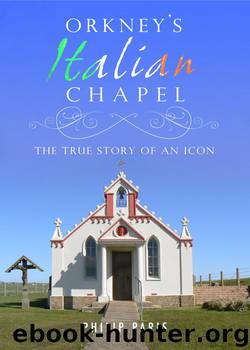Orkney's Italian Chapel by Philip Paris

Author:Philip Paris
Language: eng
Format: epub
ISBN: 9781845026141
Publisher: Black & White Publishing Ltd
Published: 2014-02-03T16:00:00+00:00
By 1944, Balfour Beatty estimated it had sufficient blocks for the barriers and Alf Hutcheon was laid off. He worked for a while as a projectionist at the Strond cinema in St Mary's, where the Italians were sometimes allowed to visit, but later trained as a mechanic.
12
The Façade
While the inside of the chapel became ever more elaborate and befitting its purpose, the outside, in particular the entrance, did nothing to convey what would be found on entering. The decision was made to create a façade, but such a creation would have to do more than simply hide the ugly frontage of a Nissen hut; it had to equal the craftsmanship of what had been achieved inside. It had to invite the passer-by to enter.
The façade was designed not by Domenico but by Pennisi, and this was where the stonemason Buttapasta proved his worth. He picked his team and work commenced. The men dug a hole at the front of the hut to create foundations, while the carpenters built various wooden moulds so that concrete blocks could be made and later assembled to match the design made by Pennisi. In many ways it was exactly like making five-ton blocks to drop into the sea, except on a smaller scale and with the need for different shapes.
Pennisi designed the façade to incorporate two lancet windows, either side of the door, and so the bricklayers — quite probably Barcaglioni and Battiato — altered the existing brickwork to match the shape and size of the intended openings. One of the carpenters set to work, making the wooden window frames.
A buttress was built at either side of the façade to add strength and balance. Each one was capped with a four-sided pinnacle. The gable is decorated with cusps, which are repeated on the bell tower and the portico pediment.
Pennisi moulded the cusp and pinnacle out of clay, which enabled him to make a plaster-of-Paris cast so that concrete replicas could be produced in the quantities required. He used the same method to create the blind arching that is fixed to the face of the façade and around the buttresses. This was painted subsequently in a terracotta colour, making it contrast sharply with the rest of the façade, which was painted white.
The façade incorporates many different influences and styles, from the rather Gothic cusps to the more classical portico, but the overall effect is one of harmony and balance. Above the entrance, in the tympanum, is Pennisi's bas-relief head of Christ. It is one of the most striking elements of the whole façade and has been made with great skill. Pennisi succeeded in capturing an expression that could be interpreted in many different ways, depending upon the person viewing it.
The bas-relief head is generally thought to be made of red clay that has been fired, but the head, like so much of the chapel, is made of cement. In this case it has been coloured red. Does that take anything away from this miniature work of art? No.
Download
This site does not store any files on its server. We only index and link to content provided by other sites. Please contact the content providers to delete copyright contents if any and email us, we'll remove relevant links or contents immediately.
| Africa | Americas |
| Arctic & Antarctica | Asia |
| Australia & Oceania | Europe |
| Middle East | Russia |
| United States | World |
| Ancient Civilizations | Military |
| Historical Study & Educational Resources |
Life of Elizabeth I by Alison Weir(2027)
The Invisible Wall by Harry Bernstein(1768)
Art of Betrayal by Gordon Corera(1403)
1916 in 1966 by Mary E. Daly(1232)
Thunderstruck by Erik Larson(1190)
The Decline and Fall of the British Empire, 1781-1997 by Piers Brendon(1099)
A Brief History of Britain, 1066-1485 by Nicholas Vincent(1013)
A Brief History of Britain, 1485-1660 by Ronald Hutton(982)
Guy Burgess by Stewart Purvis(973)
Mary, Queen of Scots by Weir Alison(965)
Henry VIII by Alison Weir(914)
The Last Lion 02 - Winston Churchill - Alone, 1932-1940 by William Manchester(910)
Lang Lang by Lang Lang(837)
1066 by Andrew Bridgeford(832)
Gimson's Kings and Queens by Andrew Gimson(817)
The Last Plantagenet by Thomas B Costain(814)
Coalition by David Laws(811)
London: A Biography by Peter Ackroyd(804)
Diana by Andrew Morton(786)
